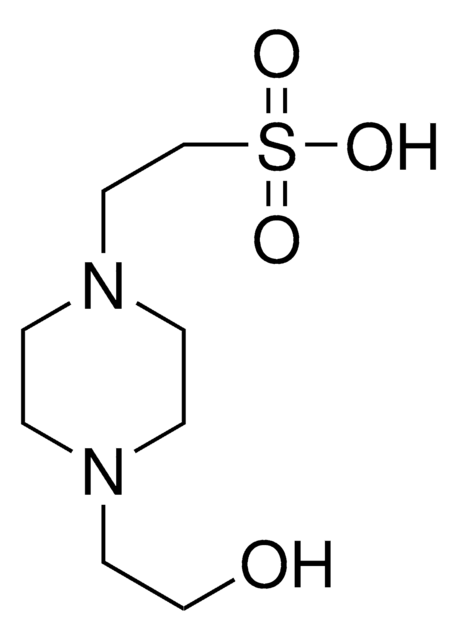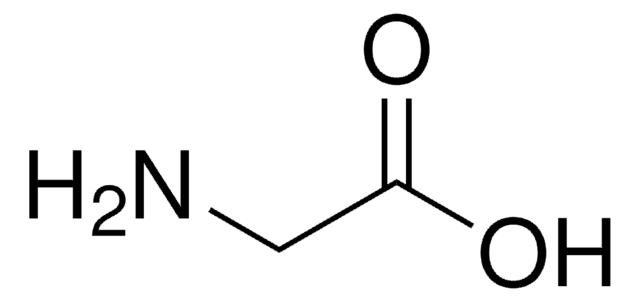H3784
HEPES sodium salt
BioPerformance Certified, suitable for cell culture, ≥99.0%
Synonym(s):
4-(2-Hydroxyethyl)piperazine-1-ethanesulfonic acid sodium salt, N-(2-Hydroxyethyl)piperazine-N′-(2-ethanesulfonic acid) sodium salt
About This Item
Recommended Products
grade
BioPerformance Certified
Quality Level
assay
≥99.0%
form
powder
storage condition
dry at room temperature
technique(s)
activity assay: suitable
cell culture | mammalian: suitable
impurities
endotoxin and total aerobic microbial count, tested
color
white
pH
10-12 (1 M in water)
useful pH range
6.8-8.2
pKa (25 °C)
7.5
solubility
water: 0.1 M, clear, colorless
density
1.19 g/cm3 at 20—25 °C
1.21 g/cm3 at 20—25 °C
absorption
≤0.02 at 280 in H2O at 0.1 M
≤0.04 at 260 in H2O at 0.1 M
suitability
suitable for component for culture media
suitable for molecular biology
application(s)
cell analysis
diagnostic assay manufacturing
general analytical
life science and biopharma
foreign activity
DNase, RNase, NICKase, protease, none detected
SMILES string
[Na+].OCCN1CCN(CC1)CCS([O-])(=O)=O
InChI
1S/C8H18N2O4S.Na/c11-7-5-9-1-3-10(4-2-9)6-8-15(12,13)14;/h11H,1-8H2,(H,12,13,14);/q;+1/p-1
InChI key
RDZTWEVXRGYCFV-UHFFFAOYSA-M
Looking for similar products? Visit Product Comparison Guide
Related Categories
General description
In cell culture, HEPES excels in maintaining stable physiological pH even amidst fluctuating carbon dioxide concentrations, outperforming bicarbonate buffers (NaHCO3). Moreover, HEPES showcases valuable properties in various biological and biochemical processes, such as isoelectric focusing for protein separation and minimal interference in DNA-restriction enzyme reactions, making it indispensable across diverse research applications, including immunoprecipitation, cell lysis, and live cell imaging. Its versatility, exceptional buffering capacity, and minimal interaction with molecules establish HEPES as a key tool in various research domains.
Application
- to supplement the HSOF medium
- as a buffer component of HCZB medium in egg and embryo culture
- as a buffer component in cell culture
Features and Benefits
- High-purity product for biochemical and biological research
- Tested to confirm low levels of heavy metal contamination, ensuring suitability for various applications
- Highly soluble in water with a useful pH range of 6.8 - 8.2 and pKa of 7.5 at 25 °C
- Suitable for Cell culture
- Tested for Endotoxins and Total Aerobic Microbial Count
- Free from DNase, NICKase, RNase, Endonuclease, Exonuclease and Protease
Physical form
Other Notes
comparable product
Storage Class
13 - Non Combustible Solids
wgk_germany
WGK 3
flash_point_f
Not applicable
flash_point_c
Not applicable
ppe
Eyeshields, Gloves, type N95 (US)
Certificates of Analysis (COA)
Search for Certificates of Analysis (COA) by entering the products Lot/Batch Number. Lot and Batch Numbers can be found on a product’s label following the words ‘Lot’ or ‘Batch’.
Already Own This Product?
Find documentation for the products that you have recently purchased in the Document Library.
Customers Also Viewed
Articles
Hepatocytes are epithelial cells found in the liver. They perform important functions, such as helping to detoxify blood, and to synthesize transport proteins, such as lipoprotein, albumin and transferrin. Primary and secondary cultures of hepatocytes are useful for studying the mechanisms of liver regeneration and differentiation.
Our team of scientists has experience in all areas of research including Life Science, Material Science, Chemical Synthesis, Chromatography, Analytical and many others.
Contact Technical Service



